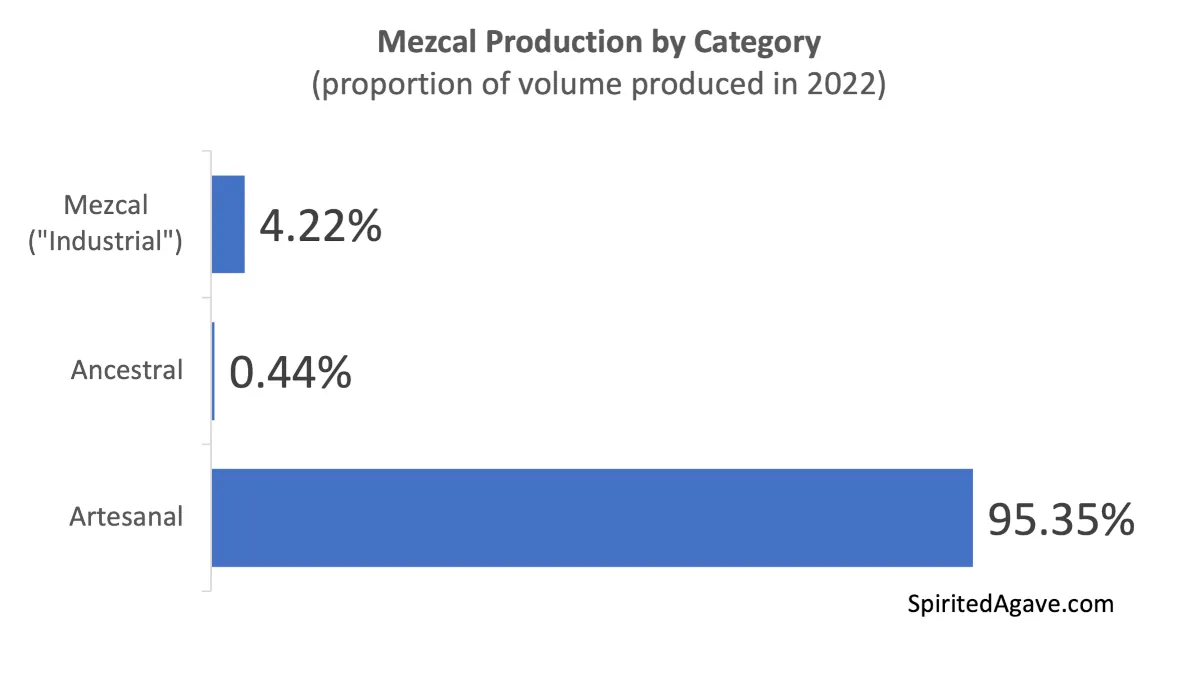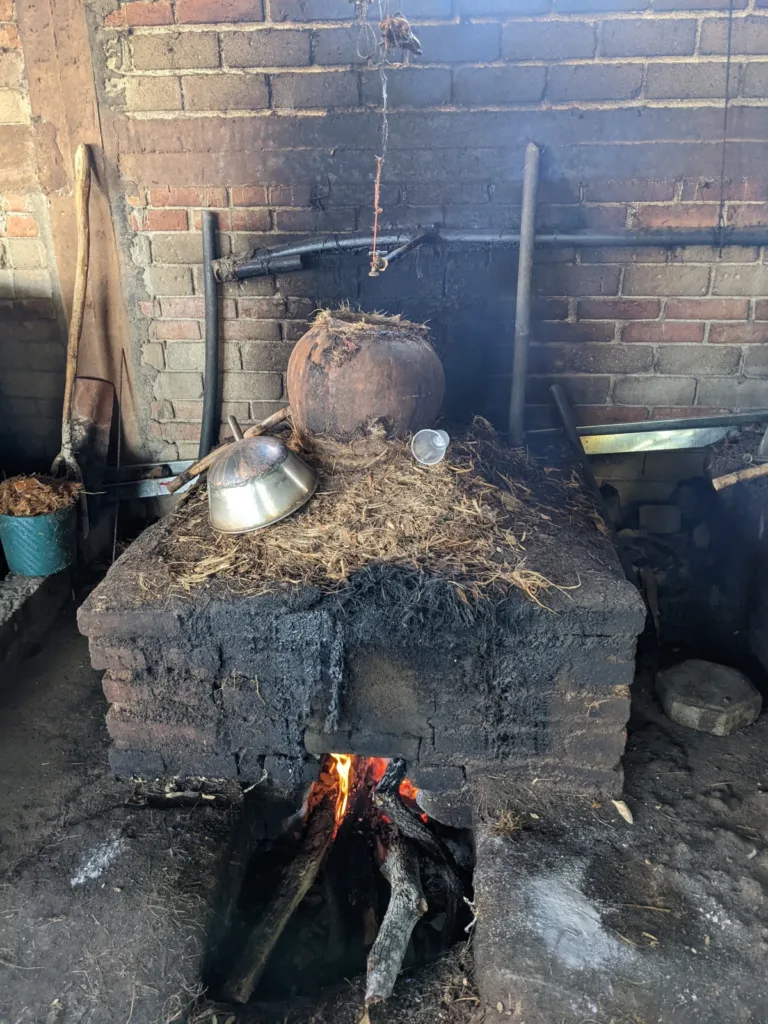The methods used for making mezcal are much more varied than for making tequila. This reflects the diversity in traditions across the wide range of mezcal producing regions in Mexico. Regulators have tried to capture the various methods used and codify the techniques under three different categories and six different classes.
These categories are Artesanal Mezcal, Ancestral Mezcal and simply Mezcal (although commonly known as “industrial” mezcal). The classes are blanco/joven, reposado, añejo, flavored mezcal and mezcal distilled with. Unlike tequila, mezcal can also be
All certified mezcal will be labeled with the category and class. In this article I’m going to cover what these classifications mean.
Mezcal vs “Mezcal™”
The terms “mezcal” or “mescal” have been used in Mexico for centuries for describing the distilled liquor made from baked agave piñas. In some parts of Mexico “mezcal” is also used for describing the agave itself.
However since 1994 the term mezcal has been protected by regulation, with the creation of a denomination of origin for mezcal. The rules were largely developed based on those for tequila with some changes.
Only liquor which is made according to specific regulations by certified producers can officially be sold as “mezcal”. The current version of the regulations for mezcal production is known as NORMA Oficial Mexicana NOM-070-SCFI-2016.
Mezcal which is not officially certified cannot use the term “mezcal” on the bottle, even if it is made using the same techniques. These spirits are known as “destilados de agave” or “liquor de agave”. Locally however, many people still use the term mezcal to refer to all agave spirits outside of tequila.
Official Categories and Classes of Mezcal
Certified mezcal comes with a category and a class. There are three categories which relate to how mezcal is produced up to distillation. There are six classes which relate to how mezcal is produced from distillation to bottling. For example, most mezcal in the Artesanal Mezcal category and in the Blanco class.
Requirements to be Sold as Mezcal
To be sold as mezcal, the product must meet the following requirements:
- It must be made from 100% mature agave (any type of agave)
- The agave must be harvested from permitted locations
- The mezcal must be made in accordance with one of the three production categories
- The producer must be authorized, and must be located within permitted locations
- The alcohol strength must be between 35% and 55% ABV
- There are further restriction on permitted levels of other elements (higher alcohols, methanol, furfural, aldehydes, lead and arsenic)
- The bottles must be labeled according to specific standards
The Three Official Mezcal Categories
Mezcal is categorized based on its method of production into three categories: Artesanal Mezcal, Ancestral Mezcal, or just Mezcal (also unofficially called “industrial mezcal”). Almost all mezcal produced is classified as Artesanal.
By contrast, the regulations for tequila do not have comparable categories. However most tequila is produced using more industrialized methods.

Artesanal vs Ancestral vs “Industrial” Mezcal: Key Differences
Production rules for Ancestral Mezcal are the most restrictive and labor-intensive. The amount of mezcal produced from a given amount of agave (yield) using Ancestral methods are generally the lowest. Here are the key differences between each mezcal category:
| Artesanal | Ancestral | “Industrial” | |
| Proportion of Total Production | 95%+ | <0.5% | ~4% |
| Cooking | Above or below ground | Below ground | Above or below ground, or autoclave |
| Milling | Hand, tahona, millstone or shredder | Hand or tahona | Hand, tahona, millstone, shredder, roller mill, or diffuser |
| Fermentation | Stone, soil, tree trunk, animal skin, wood, or clay | Stone, soil, tree trunk, animal skin, wood, or clay | Stone, wood, or stainless steel |
| Distillation | Direct flame. Copper or clay still. Clay, copper, wood or stainless-steel coils | Direct flame. Clay still. Clay or wood coils | Any still including continuous distillation |
Artesanal Mezcal Production Rules
Artesanal mezcal makes up the vast majority of all mezcal produced (more than 95%). The rules for Artesanal Mezcal are as follows:
- Cooking: Agave piñas are cooked in underground cooking pit or above ground stone basin
- Milling (crushing the agave): maul (or mallet), tahona (aka Chilean or Egyptian mills), millstone or shredder
- Fermentation: can be in stone, soil, tree trunks, animal skins, wood, or clay
- Distillation: using direct flame with stills made from copper or clay, and with coils made of clay, copper, wood or stainless steel
Ancestral Mezcal Production Rules
The Ancestral Mezcal category makes up less than half a percent of all certified mezcal.
- Cooking: Agave piñas are cooked in underground stone pits
- Milling (crushing the agave): maul (or mallet), tahona (aka Chilean or Egyptian mills)
- Fermentation: can be in stone, soil, tree trunks, animal skins, wood, or clay
- Distillation: using direct flame with stills made from clay, and with coils made of clay, or wood

Mezcal (Industrial Mezcal) Production Rules
Certified mezcal that is not made using the standards of Artesanal or Ancestral Mezcal is labeled simply as Mezcal. This kind of mezcal is commonly, though not officially, called industrial mezcal. Despite what you might expect, this kind of mezcal only makes up less than 5% of all certified mezcal produced. The production rules for this category of mezcal is as follows:
- Cooking: Agave piñas are cooked in underground cooking pit or above ground stone basin or an autoclave
- Milling (crushing the agave): maul (or mallet), tahona, Chilean or Egyptian mill, millstone, shredder, roller mill, or diffuser
- Fermentation: can be in stone, wood, or stainless steel
- Distillation: any still, continuous distillation, or with coils made of copper or stainless steel
The Six Official Mezcal Classes
The three categories of mezcal deal with how mezcal is produced up to distillation. Certified mezcal is further classified into six classes based on what happens from distillation up to bottling. By production volumes the vast majority of mezcal is simply Blanco. The six classes of mezcal are:
- Blanco or Joven
- Matured in Glass (Maduro en Vidrio)
- Reposado
- Añejo
- Flavored with (Abocado con)
- Distilled with (Destilado con)
Differences Between Classes of Mezcal
Blanco or Joven Mezcal
Mezcal labeled as Blanco or Joven has had no further processing following distillation except for usually adding water. It is clear and colorless. 98.78% of certified mezcal is Blanco according to COMERCAM.
There is a difference between tequila labeled “Joven” and mezcal labeled “Joven”. With mezcal, blanco and joven are the same. However when referring to tequila, joven signifies a blend of unaged and aged tequila.
Matured in Glass Mezcal (Maduro en Vidrio)
Mezcal stored in a glass container for at least 12 months. The storage area must be underground or in a space with limited variations of light, heat and humidity.
This is a very rare class of mezcal. This technique is sometimes used in the states of Michoacan and Guerrero and more recently in Oaxaca. Aging mezcal in this way changes the flavor and texture, resulting in a smoother, more rounded tasting mezcal.
Reposado Mezcal
Aged in wooden barrels of any size for between two and 12 months in a space with limited variations of light, heat and humidity.
While very common with tequila, aging mezcal is not so common. Some more commercial brands like Ilegal, 400 Conejos and Zignum offer aged expressions.
Añejo Mezcal
Aged in wooden barrels less than 1000 liters for more than 12 months in a space with limited variations of light, heat and humidity.
Mezcal Flavored with (Abocado con)
Mezcal that has had ingredients added to the finished product fit in this category. This includes the most famous addition, the maguey worm. Other ingredients sometimes added include damiana, lime, honey, orange and mango.
Mezcal Distilled with (Destilado con)
Mezcal that has been distilled with other ingredients. This resulting mezcal is commonly known as a “Pechuga”. Pechuga translates to “breast” and references a traditional celebrity mezcal which undergoes a third distillation with a turkey or chicken breast as well as fruits and spices.
Non-Certified Mezcal Production
A lot of mezcal produced in Mexico hasn’t been certified. Officially, these products cannot be sold as mezcal and should be labeled as “destilado de agave” or similar. Some producers chose not to get certified due to the added costs. Many others are unable to be certified because they are in a region outside of the Denominación of Oregen.
Unlike tequila, there are a huge number of mezcal producers making agave spirits without being certified. Some of the best mezcals I have tried were not certified. Real Minero is a common example of one of the highest quality agave spirit producers which does not make certified mezcal. This is despite them meeting all of the requirements for certification.
There are many more tiny producers for whom it just doesn’t make sense to certify given their low production volumes.
On the other hand certification is definitely no guarantee of quality. If nothing else though, it should be a guarantee that you won’t go blind from drinking it.
